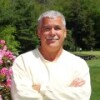ORLANDO, Florida — For the first time ever, golf has a new leader in the clubhouse — and it’s all the off-course activity that is now surrounding the game.
David Lorentz, the top researcher for the National Golf Foundation, in his state of the game address Wednesday at the 70th PGA Show at Orange County Convention Center, announced that off-course golfers hit 27.9 million in 2022, with green grass participation at 25.6 million.
That’s a first, and quite eye opening for a traditional sport that is staring down a long fairway of consumer change.
Off-course activity included anyone who has participated in any combination of driving range, entertainment golf or some indoor golf simulator activity with club-and-ball experience. This does not include miniature golf.

"Otherwise, this would be an even larger number," Lorentz says. "We’ve all been following this movement in golf over the past decade. Golf is finding new times and new places to grow and thus gain interest, mind share and wallet share."
Cha-ching.
For example, Topgolf, the nation’s leader in climate-controlled golf that that feature HD TVs in every hitting bay in a bar/restaurant type of atmosphere, had just four locations in 2011. It now boasts 80 across the country.
In addition, the PGA Show hosted more than a dozen simulator type of exhibitors on the Show floor in what is a rapidly growing golf business model.
"A simulator can work for anyone. You can use it in a commercial setting, in a professional setting, in your home — anywhere you have room," says Dennis Van Drie, CEO of ProTee United in The Netherlands.
Van Drie is in his early 50s and has been in the business for 22 years in Holland, billing his company’s product as "The Ultimate Simulator Experience."
"I am 52 years old and I have a dad in his 70s and we come from a generation that hasn’t seen this before — it was too expensive, or you would rather play outside and enjoy the air," he says. "But the youngsters, the newer generation, they love this stuff. They want to stay indoors. For the golfer that wants to go play outside but does not have time they can play a round of golf on a simulator in an hour-and-a-half.
"The audience is changing and in addition to golf you have all sorts of other games with this simulator. You can start them off at the age of 4, get them used to it and get them into golf, and then go on the real course at some point."
Lorentz says Van Drie may be on to something.
"For a while, half the room felt this was helping the green grass industry and the other half was convinced it was hurting," Lorentz says of off-course golf activity. "Those who felt off-course golf was a net negative have used zero sum thinking, that there is only so much time and attention and discretionary money to go around, and that off-course golf was only siphoning those things from traditional green grass.
"It’s a fair question to ponder and certainly everyone has an opinion, but the data doesn’t really support it. There are a number of ways we’ve looked at this. We’ve talked to people who are engaged both on and off course and a very tiny percentage use the rationalization that they are playing less on the golf course because of their engagement off the course."
The National Golf Foundation recently partnered with Topgolf on a survey of off-course trends.
“[They] were as curious as we were at the same time," Lorentz says. "We wanted to do research to better understand the role in the relationship between on-and-off course golf. We found that most people who come into golf via off course are becoming much more emotionally prepared for green grass play — they are more confident, they see that more people like golf than expected, and they are experiencing the thrill of hitting a really good shot.
“You couldn’t possibly overstate the importance of this in creating demand for golf. This is the drug that hooks people to the game. At NGF we refer to this as ‘shot euphoria.’ And historically it has been the single biggest differentiator between the person who stays with golf and becomes committed and someone who leaves. Those in the green grass business should feel very fortunate to have these experiences that are administering the golf drug to now millions more people.”
Despite the connection that appears to be positive for growth of the game there are items that off-course play isn't solving.
"And we shouldn’t expect them to solve," Lorentz says. "There are clearly gaps in delivering to consumers. New golfers with a high level of interest in playing green grass still lack the clarity and the confidence to be able to approach the golf course on their own.
"This is without a doubt, the biggest opportunity in golf right now. The key — and I know I’m stating the obvious — to unlocking growth in the green grass business will be to address this barrier. There is still way to much logistical and emotional friction in the golf customer journey, even in places where logistically it could not be any easier to take up green grass after trying the off course game."











